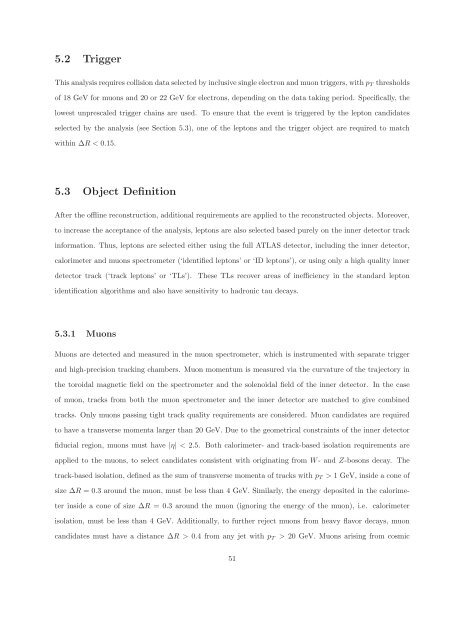CERN-THESIS-2012-153 26/07/2012 - CERN Document Server
CERN-THESIS-2012-153 26/07/2012 - CERN Document Server
CERN-THESIS-2012-153 26/07/2012 - CERN Document Server
Create successful ePaper yourself
Turn your PDF publications into a flip-book with our unique Google optimized e-Paper software.
5.2 Trigger<br />
This analysis requires collision data selected by inclusive single electron and muon triggers, with pT thresholds<br />
of 18 GeV for muons and 20 or 22 GeV for electrons, depending on the data taking period. Specifically, the<br />
lowest unprescaled trigger chains are used. To ensure that the event is triggered by the lepton candidates<br />
selected by the analysis (see Section 5.3), one of the leptons and the trigger object are required to match<br />
within ∆R < 0.15.<br />
5.3 Object Definition<br />
After the offline reconstruction, additional requirements are applied to the reconstructed objects. Moreover,<br />
to increase the acceptance of the analysis, leptons are also selected based purely on the inner detector track<br />
information. Thus, leptons are selected either using the full ATLAS detector, including the inner detector,<br />
calorimeter and muons spectrometer (‘identified leptons’ or ‘ID leptons’), or using only a high quality inner<br />
detector track (‘track leptons’ or ‘TLs’). These TLs recover areas of inefficiency in the standard lepton<br />
identification algorithms and also have sensitivity to hadronic tau decays.<br />
5.3.1 Muons<br />
Muons are detected and measured in the muon spectrometer, which is instrumented with separate trigger<br />
and high-precision tracking chambers. Muon momentum is measured via the curvature of the trajectory in<br />
the toroidal magnetic field on the spectrometer and the solenoidal field of the inner detector. In the case<br />
of muon, tracks from both the muon spectrometer and the inner detector are matched to give combined<br />
tracks. Only muons passing tight track quality requirements are considered. Muon candidates are required<br />
to have a transverse momenta larger than 20 GeV. Due to the geometrical constraints of the inner detector<br />
fiducial region, muons must have |η| < 2.5. Both calorimeter- and track-based isolation requirements are<br />
applied to the muons, to select candidates consistent with originating from W- and Z-bosons decay. The<br />
track-based isolation, defined as the sum of transverse momenta of tracks with pT > 1 GeV, inside a cone of<br />
size ∆R = 0.3 around the muon, must be less than 4 GeV. Similarly, the energy deposited in the calorime-<br />
ter inside a cone of size ∆R = 0.3 around the muon (ignoring the energy of the muon), i.e. calorimeter<br />
isolation, must be less than 4 GeV. Additionally, to further reject muons from heavy flavor decays, muon<br />
candidates must have a distance ∆R > 0.4 from any jet with pT > 20 GeV. Muons arising from cosmic<br />
51















